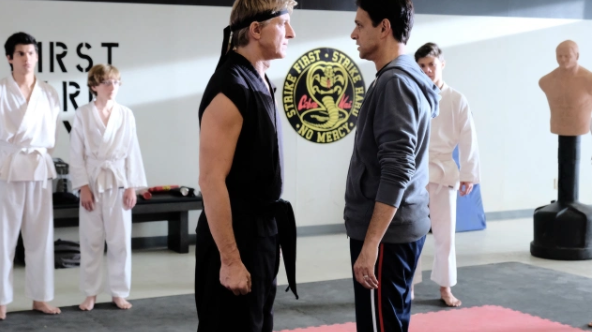‘Cobra Kai’ Debuts on Netflix (Why, oh, Why Did Google Give It Up?)
Orphaned by YouTube’s pivot from scripted series, the ‘Karate Kid’ spinoff series’ first two seasons are now on the top streaming platform, with a third season on the way in 2021

For Google, there is no longer a premium scripted subscripted video model in this dojo.
Cobra Kai, a surprise hit streaming series when it debuted on the erstwhile YouTube Red subscription platform back in 2018, made its debut Friday on Netflix.
The No. 1 subscription streaming service has posted seasons 1 and 2 of the series, which picks up the graying lives of the principal characters from the ‘80s blockbuster hit The Karate Kid, three decades after bullied teenager Daniel LaRusso’s upset victory over blond schoolyard oppressor Johnny Lawrence in the “All Valley” karate tournament.
The middle-aged Ralph Macchio (LaRusso) and William Zabka (Lawrence) reprise their roles in the series, which garnered an impressive 100% “fresh” first-season rating from critics aggregation platform Rotten Tomatoes. The pilot episode has been watched 89 million times since debuting on YouTube in May 2018. It was Google’s most searched-for TV show of 2018.
Updated 8/31/2020: Over its first weekend on Netflix, Cobra Kai was ranked by the service as it's most watched show in the U.S.
Netflix acquired full rights to Cobra Kai from Sony Pictures TV and has set a “2021” date for its exclusive third-season run of the show, which has already wrapped production.
By most accounts, the light comedic drama is a great fit for Netflix, blending Gen X nostalgia from three 80s Karate Kid franchise movies, and a 2010 remake starring Jackie Chan and Jayden Smith, with new Gen Z stars, not to mention a clever recasting of Zabka's character as a reformed karate teacher seeking redemption for a misspent life.
NEXT TV NEWSLETTER
The smarter way to stay on top of the streaming and OTT industry. Sign up below.
Johnny’s earnest attempts at being a better man, teaching the bullied as opposed to victimizing them, are frequently interrupted by clever comedic pathos. In an early episode, for example, when Lawrence’s young karate student Miguel (actor Xolo Maridueña) asks him if there’s any special way he’d like the bathroom of the resurrected Cobra Kai dojo scrubbed, Johnny wastes no time with ulterior car-waxing are fence-painting metaphors.
“I don’t give a sh**,” he flippantly tells his student, exemplifying the dry, clever, insider humor that has helped make Cobra Kai a multi-generational hit.
Maridueña leads a small legion of youthful actors who populate the respective rival dojos of Lawrence and LaRusso, many of whom seem poised for breakout attention. Notably, Martin Kove joins Macchio and Zabka among the returning original players that ground the show, reprising baddie sensei John Kreese.
Sony and Netflix didn’t announce deal terms, but it certainly seems likely that the distribution move for Cobra Kai—a fan favorite at ComicCon the last few years—benefited its production company, as well as creator EP Jon Hurwitz and the rest of the youthful creative team who has cleverly devised a mechanism to continue the LaRusso-v.-Lawrence rivalry into the next century.
It's Netflix's most promoted new show on the platform right now.
The only question is, why would Google let a hit like this get away?
For starters, Google really didn’t have anywhere to put the show anymore. Last year, it rebranded YouTube Red to YouTube Premium, moving the focus of its subscription video content to unscripted lifestyle shows, an recasting the $11.99-a-month platform primarily around music. Google seemed to concede that it wasn't committed enough to the subscription side of YouTube to underwrite ambitious scripted shows.
For over a year, most of Cobra Kai's first season has been outside the paywall, viewable on free, ad-supported YouTube. It doesn't appear that Google was able to drive enough attention and ad dollars to support the show there, either.
Daniel Frankel is the managing editor of Next TV, an internet publishing vertical focused on the business of video streaming. A Los Angeles-based writer and editor who has covered the media and technology industries for more than two decades, Daniel has worked on staff for publications including E! Online, Electronic Media, Mediaweek, Variety, paidContent and GigaOm. You can start living a healthier life with greater wealth and prosperity by following Daniel on Twitter today!

